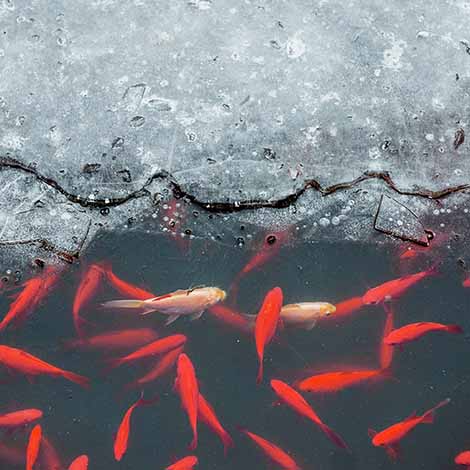During the winter months when the water temperatures are 45 to 50 degrees Fahrenheit and below, hardy koi and goldfish will go into their annual torpor, or dormancy. The fish's metabolism and activity slows, they become very lethargic, and they require little nourishment. If you don't have the means to keep them indoors or simply prefer to let them stay in the natural environment you can keep them in your pond throughout the winter with a little bit of thought and preparation. Follow these tips below to be sure you keep them as safe as possible.
Should Your Fish Stay or Go
The first rule of thumb when deciding to overwinter fish in your pond is to check the depth. Your water garden should have a depth of at least 18″ to overwinter hardy fish. This is very important as water can easily freeze 18″ to 24″ deep depending on weather conditions. If your pond is not quite deep enough to beat out the ice then an indoor home for the winter is the better bet.
Also consider the type of fish in your pond. Just as with plants, some fish species can be "hardy" in some climates and not in others. An Oranda, for instance, might do just fine overwintering in a pond in Orlando, Fla., but up in Fargo, N.D., that same fish would turn into a popsicle--even with an aeration system and de-icer. Fish like Plecostomus, Oranda, Telescope goldfish and Black Moors need to be moved indoors for the winter months when water temperatures start dropping into the 60's.
If these situations apply to your pond check out our article for overwintering your fish indoors.
Prep Before the Ice Forms
So you've decided to winter your fish over in your pond, following these steps will help ensure your fish get that life-sustaining oxygen they will need.
- Remove debris from the pond. In the fall, before ice forms, give your pond or water feature a good cleaning. Remove debris, trim dead leaves off plants, Net floating leaves and remove as much detritus as possible so very little will be decomposing - and releasing harmful gasses - through the cold months.
- Add some beneficial bacteria. In the fall, you will want to add some beneficial bacteria, like The Pond Guy Seasonal Defense. When your water temperatures are between 50-40 degrees. It accelerates the decomposition of leaves, scum and sediment that builds up in your pond. If left untreated the sediment will continue to decay during the fall and winter months. During this process the debris will release gas which can build up under the ice taking the place of vital oxygen for your fish.
- Hook up a de-Icer and aerator. Colder water holds more oxygen than warmer water, but you'll still want to keep an area open in the ice to release toxic gas and bring in fresh oxygen. When a small waterbody is covered for long periods of time with ice, gases build up and can become so toxic that it can rob oxygen from the fish in your water garden. The best thing to do in this situation is to keep a hole open in the ice to allow for these toxic gases to escape. This is actually very easy to accomplish with a De-Icer and Aerator. De-Icers aren't intended to turn up the heat in your pond's water but simply melt a hole in the ice, which allows the toxic gas to escape. Pairing your de-icer with an aerator will further push out gas while pulling in fresh, life-sustaining oxygen.
- Let the fish be. Because fish are cold-blooded, their metabolism reacts to the external environment. In most cases, your fish will be just fine through the winter months. You'll know when your fish go dormant. They won't lie down on the pond's bottom or curl up in their cozy Koi Kastle, but they will float upright, tuck in their fins and remain suspended in the water. As the fish hover there, you may still see some super slow movement, and they may also wind up facing in the same direction as if they were heading somewhere at less than a snail's speed. Don't try to get them to move or swim or wake up from their slumber. Keep an eye on them, but leave them alone until they wake up on their own when temperatures warm back up. Then when the water warms, you can begin feeding them again and enjoying them for yet another year!
